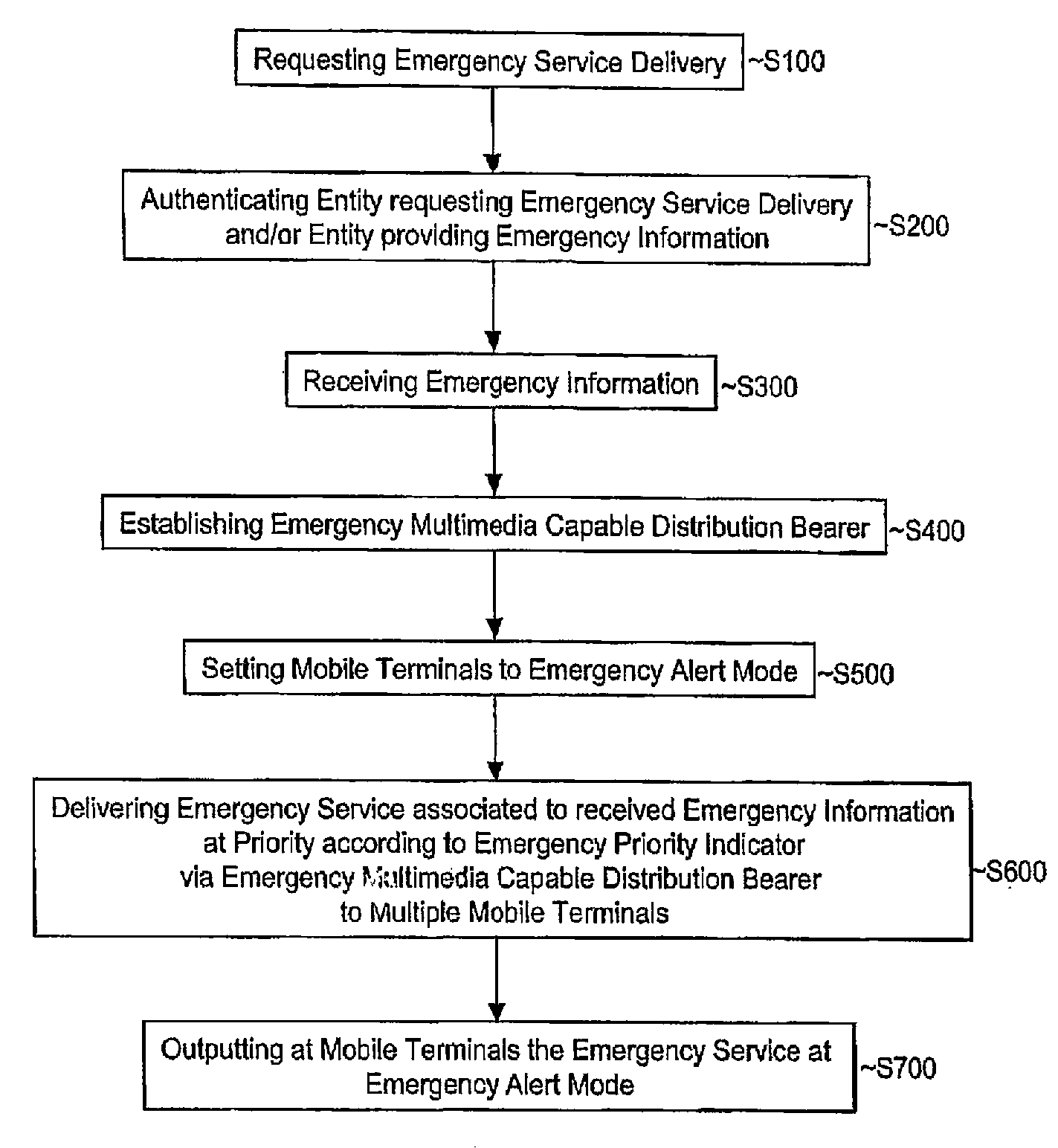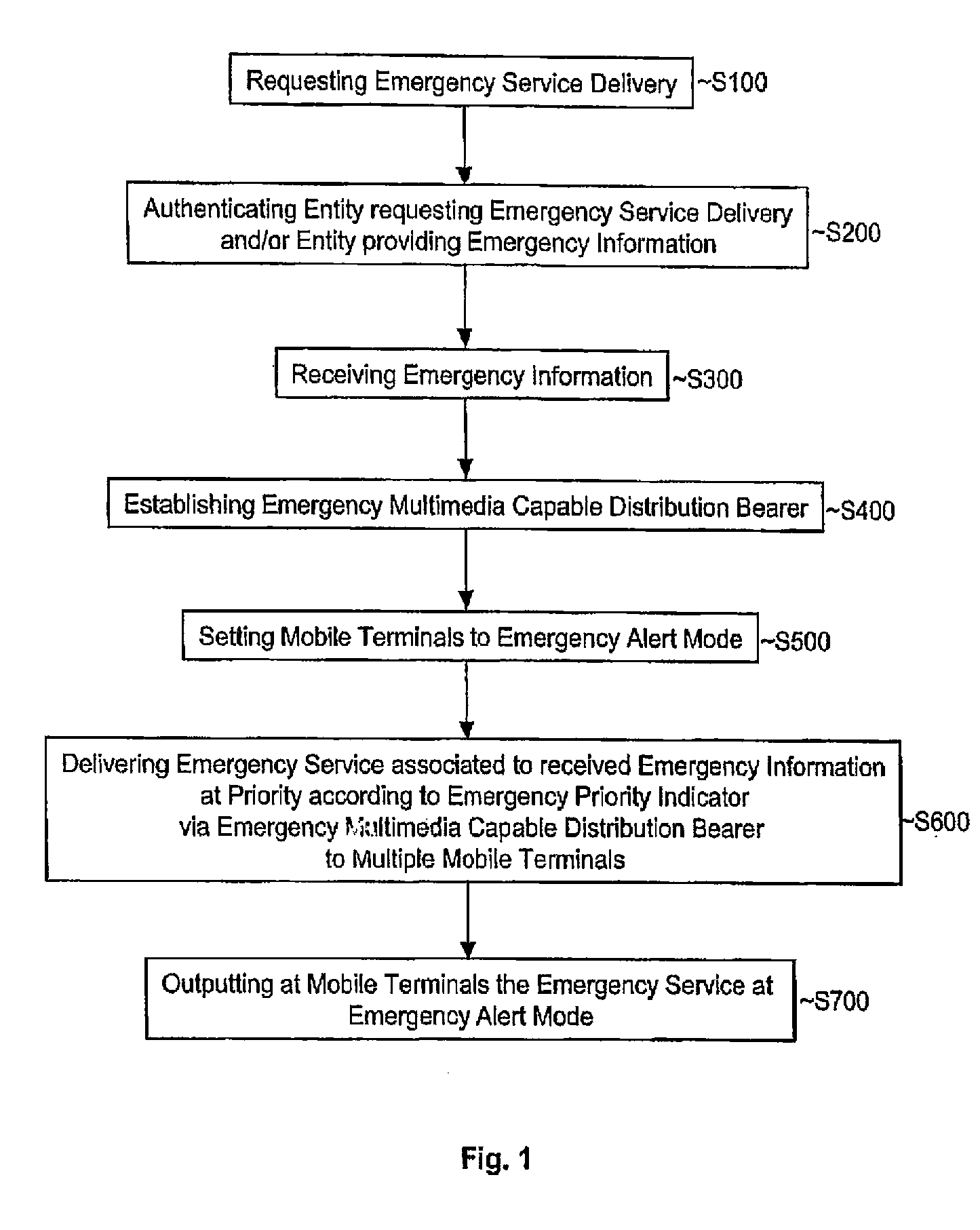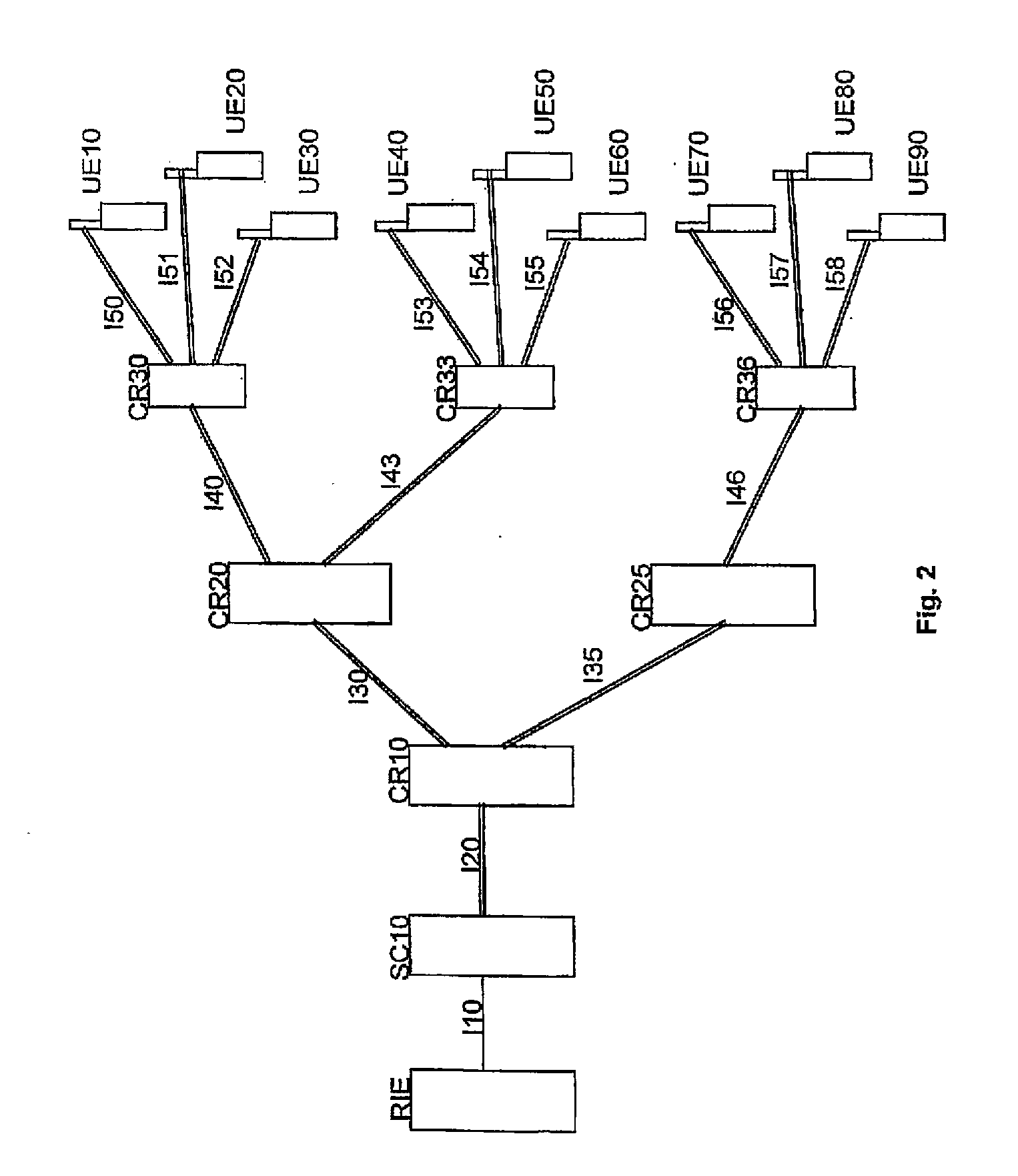[0013]The invention provides many advantages compared to existing emergency alert systems. Any kind of emergency service in any kind of multimedia format can be delivered to the recipient mobile terminals, especially the emergency service is not restricted to short text only. Accordingly, cumbersome, error-prone, and time-consuming conversion of emergency information to short text is not needed thus saving valuable time, increasing information scope and content, and avoiding misinterpretations. All instances of the delivery chain may be adapted to prioritize the delivery of the emergency service via the emergency multimedia capable distribution bearer to the mobile terminals thus decreasing delivery time, reducing loss of data, improving
quality of service, and lowering susceptibility to
network congestion. Furthermore, the emergency service delivery via the emergency multimedia capable distribution bearer is open to many communication techniques and does not have to rely on the manual activation of reception settings at the respective mobile terminals. In the end, a fast, reliable, and secure distribution channel for informing mobile terminals about an emergency event in any kind of multimedia format with a
high rate of informed mobile terminals is achieved.
[0015]According to a further preferred embodiment, the emergency priority indicator can be selected from a group of emergency priority indicators each indicating an emergency priority level and the selected emergency priority indicator can be associated with the emergency multimedia capable distribution bearer such that the emergency service delivery to the multiple mobile terminals can be accomplished according to the emergency priority level of the selected emergency priority indicator. Selection criteria may be an identity of an entity that requests the emergency service delivery and / or an identity of an entity from that the emergency information is received. Further criteria may be an indication of a severeness and / or an urgency of the emergency event, and / or one or more identities associated with the mobile terminals to which the emergency service is to be delivered. Selecting an emergency indicator from a group of emergency indicators each indicating an emergency priority level and associating the selected emergency priority indicator thus provides larger flexibility by a differentiated prioritization within emergency service delivery.
[0018]According to further preferred embodiment, the multiple mobile terminals are set to an emergency alert mode for a clearly human-recognizable
perception of the delivered emergency service, i.e. current settings of a mobile terminal can be changed by e.g. overwriting with emergency alert mode settings such that the emergency service can be presented to a user in a most perceptual way. By setting a mobile terminal to an emergency alert mode, the mobile terminal's output level may be tuned to highest possible level and some user-interaction possibilities may be at least temporarily constrained or even deactivated. An immediate reception and
processing of the emergency service for an immediate and clearly noticeable presentation of the emergency service to the user is possible by the setting to the emergency alert mode. The setting to the emergency alert mode can occur most preferably automatically in a network-controlled, user-hidden and silent way as a
background process on the mobile terminal without any user-interaction. All in all, setting the mobile terminals to an emergency alert mode for a clearly human-recognizable
perception of the delivered emergency service increases in the end the number of informed users as an emergency service that is received by a mobile terminal can no longer be missed by the corresponding user just because of the mobile terminal's current settings, e.g. in case the current settings effect a muting of the output unit(s) of the mobile terminal the user may miss a received emergency service and is thus not informed of the emergency event.
[0019]According to a further preferred embodiment, an emergency alert mode activation indicator can be sent to the mobile terminals for an activation of the setting to the emergency alert mode. Alternatively or in addition, an emergency alert mode setting instruction can be sent to the mobile terminals for instructing the mobile terminals for the setting to the emergency alert mode. Using an emergency alert mode indicator being preferably standardized uses minimum messaging effort compared to an emergency alert mode setting instruction like a self-
executable program file or
Java-script. However, this
advantage of less transferable data and minimized network load has to be balanced against the possibility that mobile terminals may exist that do not possess the capability to change their settings to the emergency alert mode according to said emergency activation indicator because the underlying settings are not available at such terminals or that those terminals are not capable of
processing or recognizing such indicator which motivate for the sending of an emergency alert mode setting instruction for informing these kinds of mobile terminals.
[0020]According to a further preferred embodiment, the emergency priority indicator and the emergency alert mode activation indicator are one indicator, which can reduce the implementation and
processing complexity as only one indicator for serving both purposes of emergency service delivery prioritization and emergency alert mode setting has to be defined and processed at the respective entities.
[0021]According to a further preferred embodiment, the multiple mobile terminals may be allocated to a group of mobile terminals and the emergency service is delivered to the group via the emergency multimedia capable distribution bearer. This group-wise treatment allows to provide group-specific emergency service to a group of mobile terminals thus increasing flexibility and security of the method as e.g. a group of mobile terminals associated to a group-type “firemen” may be provided with firemen-specific instructions related to the emergency event that are not intended to be delivered to public mobile terminals or further groups (to whom further group-specific emergency services may be delivered accordingly).
 Login to View More
Login to View More  Login to View More
Login to View More 


